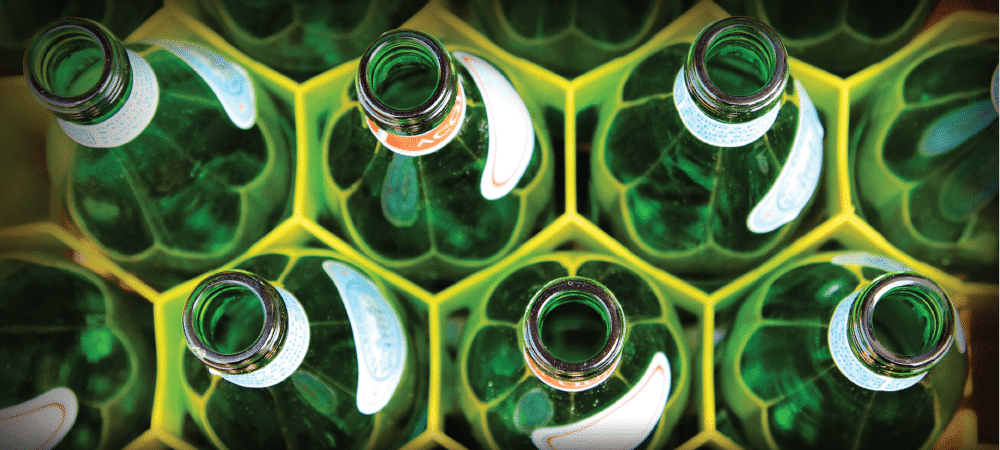Customers really care about sustainability when they are thinking about which products to buy. Global warming and climate change are on everyone’s minds. That’s why it’s so important to think about sustainability when choosing how to package your products. Luckily, there are many creative solutions that will help you create more sustainable packaging.
Make your packaging out of natural resources instead of plastic
One way to make your packaging more sustainable is to get rid of the plastic and use natural resources, instead. The simpler the packaging the better. Think recycled paper and plain black ink.
A recent campaign for the World Wildlife Fund highlighted the importance of sustainable packaging by displaying natural solutions to everyday problems in simple packages made out of recycled paper. The product line bears the simple name just.* Each of the packages has a die-cut in the shape of a plastic bottle, and the buyer can see through the package to the natural resource inside.
For example, one of their packages contains lemons and the words “Make your own glass cleaner.” The just* campaign showcases brilliant design, sustainable packaging, and a push for people to use more natural resources, as well.
Make it easy to recycle
Making your packaging recyclable is one of the most important things you can do if you care about sustainability. Luckily, there are lots of ways to make sure your packaging is recyclable, some of which you may never have thought of before.
Here are a few ideas from Brand Packaging:
- Start with materials that are commonly recycled in most places.
- Design the package with a single material. Single material packages can be more easily sorted.
- Make your package as small as possible.
- Try to stick with only one package instead of including multiple layers of packaging for your product.
- Make it easy for a user to take your packaging apart.
Many of these ideas focus on making it as easy as possible for customers to recycle your packaging. When a customer has to wonder about how to take your product apart or which recycling pile to put it in, it is much less likely to be recycled. Make it as convenient as humanly possible to recycle your packaging.
Be certain your paper is actually recyclable
Paper may seem like the most recyclable material you can find, but it’s actually a little more complicated than that. A lot of packaging is made from paperboard, which is recyclable, but if your product is temperature sensitive or has a shorter shelf life like food, that paperboard needs to provide the right conditions for your product to stay fresh. Many manufacturers get around this by adding a polymer barrier coating to the packaging. The recycling plants then need to remove the polymer before they process the paper itself, which makes it more costly and complicated to recycle.
One of the first steps to recyclable paper packaging is to become aware of whether your packaging is actually recyclable or not. Challenge your assumption that your paper packaging can be recycled and get curious about whether it has a polymer barrier. If it does, think about replacing it with renewable barrier packaging board that will protect your product while keeping your packaging sustainable.
Be aware of your entire supply chain for packaging
You should also be aware of the entire supply chain for your packaging. Even if your direct supplier uses recyclable materials, what about the supplier above them? Are you certain that their practices are sustainable? The more you know about where your packaging comes from, the better able you’ll be to make sure it is truly sustainable.
Use recycled materials to create naturally beautiful packaging
Fitzroy designed a line of rum bottles that are a perfect example of how you can make every part of your packaging simultaneously sustainable and beautiful. The caps on the bottles are made from recycled Coca Cola packaging that was polluting the Dutch beaches of the North Sea Islands. The bottles themselves, made from recycled glass picked up on the same beaches, can be reused as water bottles. And since the marble tops are so beautiful, people naturally want to reuse them.
You’ve got to love their tagline, as well. “From waste to wasted.”
Get inspired by L’oreal’s sustainability efforts
L’Oreal USA has made impressive efforts to use sustainability in all facets of its operations and packaging.
For example, their Biolage R.A.W. hair care line uses 100% recycled plastic bottles and a 98% biodegradable formula. The company is also developing a proprietary eco-design tool to check the environmental impacts of each of their product’s life cycles.
Some of their other products, including Pureology and and Garnier Fructis, have bottles made of 50% recycled plastic.
As you can see, even packaging made from plastic can be sustainable. So if your product needs plastic packaging, know that you can still do your part to protect the environment.
Sustainable packaging doesn’t mean boring packaging
If you’ve avoided using sustainable packaging for your products because you think it will be less appealing to your customers, rethink your assumptions about what sustainability means.
As you can see from some of the projects above, an emphasis on sustainability can actually help you be more creative with your packaging, like the World Wildlife Fund did with their just* project and Fitzroy did with their rum bottles. Not only is their packaging unique and innovative, it also tells a story that makes customers excited to get onboard with their products.
If you’re looking for a new package design that is sustainable and beautiful, our sustainable beauty packaging design agency can help your next beauty brand stand out and make a positive impact on the environment.



